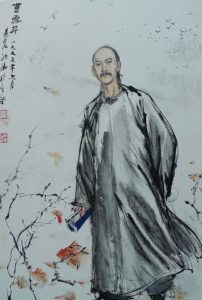Authorship

“No one knows who is the author of this book.” So begins an early printed edition of the novel Honglou meng, published by Cheng Weiyuan 程偉元 in 1791 (Saussy, “Author,” 122). The question of who wrote the novel became of sharp interest in the early twentieth century, with scholars such as Yu Pingbo 俞平伯 (1900-1990) and Hu Shi 胡適 (1891-1962) writing essays to argue that the author of Honglou meng was Cao Xueqin 曹雪芹. There is today little doubt among scholars that Cao Xueqin 曹雪芹 is the author of the first eighty chapters of the novel. The authorship of the final forty chapters is still the subject of controversy.
But despite the best efforts of many scholars, we still know relatively little about the life of Cao Xueqin. We do know that Cao was the grandson of Cao Yin 曹寅 (1658-1712), who served as both Textile Commissioner and Salt Commissioner and amassed a great fortune, substantial social prestige, and imperial favor. He had a close relationship with the Kangxi 康熙 emperor, which we can see demonstrated in their correspondence which is reproduced on the text boxes at the bottom of this page. However, he died with substantial debt, which cast a pall over the family’s fortunes. The Kangxi 康熙 emperor’s intervention saved the family from immediate catastrophe, but catastrophe did come soon after Kangxi’s 康熙 death in 1722. Cao Fu 曹頫, Cao Yin’s 曹寅 young nephew and adopted son, was appointed Textile Commissioner and soon accumulated more debt. In 1728 he was dismissed from the textile office, and the fact that the office was in arrears was the formal reason for his dismissal. But there may have been other reasons. After the death of the Kangxi 康熙 emperor, complex negotiations as to which of his 20 surviving adult sons would succeed him ensued. (The Manchu rulers of the Qing dynasty did not practice primogeniture; succession went to the most capable son rather than automatically to the first-born son.) The Cao 曹 family had not backed the Yongzheng 雍正 emperor in his quest for the emperorship, and there may have been an element of revenge in the spectacular fall of the family.
It does not take a narrow autobiographical reading of the novel to see how the experience of Cao Yin 曹寅 influenced his grandson’s novel. The most important way in which the Cao family experience influenced the novel is in the story of a grand family’s fall from wealth, power, and grace. For more about the ways in which the Cao 曹 family misfortunes had an impact on the novel, see the section Qing politics.
The biography of Cao takes on a particular significance because a number of scholars argue that the Dream of the Red Chamber is an autobiographical account and that the character Baoyu represents an idealized version of Cao himself. Scholars advocating that view include Zhou Ruchang, who delivered a popular series of lectures on Chinese television advocating this position.
The most extensive scholarship on Cao Yin in English can be found in Jonathan Spence’s Ts’sao Yin and the Kang-hsi Emperor and Zhou Ruchang’s Between Humble and Noble, both of which are in the suggestions for further reading section of this Pressbook. The introduction to the Hawkes translation of the novel (under the title Story of the Stone) also provides substantial information about the Cao family. Haun Saussy has written on the question of authorship of the novel, both in “Authorship and The Story of the Stone: an Open Question” in Schonebaum and Lu and “Authorship.”

